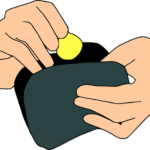 Lawyers become lawyers, in large part, because they can’t, or don’t want to, do math.
Lawyers become lawyers, in large part, because they can’t, or don’t want to, do math.
Judges are lawyers who got promoted.
And therein is the root of the problem with “no look” attorneys fee for consumer bankruptcy cases.
Judges don’t understand mathematics. They expect the “law” of averages to result in fair compensation for debtor’s lawyers, relieving judges of having to consider and approve an appropriate fee case by case.
Only the law of averages doesn’t work on small numbers: small numbers like the number of cases a consumer lawyer handles in a year.
The problem
The Bankruptcy Code empowers judges to review the debtor’s financial transactions with his attorney. Chapter 13 enables individuals to reorganize their financial affairs over a three to five year period. The help of a lawyer is virtually required to make that happen.
Ask any judge and, almost invariably, their least favorite judicial task is considering fee applications. Because the job is tedious, the total dollars relatively small next to the Chapter 11 fees that most judges earned before they took the bench, the bench has looked for streamlined ways to compensate consumer lawyers.
That streamlining took the form of adoption of a presumptively fair fee for Chapter 13 work, which the court would approve without “looking”, that is, without detailed applications, notice, or a hearing. In its original form, counsel were free to seek additional fees by application, supported by time records and a narrative.
No look fee arrangements were appealing both to bench and bar because it side stepped the cost of preparing a fee application and, for many attorneys, gave them cover for not keeping time records.
The process started to go off the rails when courts started building limitations on the ability of counsel to apply for additional fees. Some times, and places, electing the no look fee was irrevocable. Other places, one had to show that the additional fees sought were unanticipated or extraordinary.
Counsel then are called on, at the beginning of a five year relationship with the client to figure out what can be anticipated in the upcoming 60 months from this client, with the client’s current set of problems, in an economy we can only guess about.
What assumptions do we make about the client’s responsiveness? the state of their records? the likelihood they’ll stay married? employed? healthy?
Yet counsel rolls the dice at the beginning of the case when deciding whether to elect the no-look fee or not.
And when the case runs off the rails, the facts turn out to be different, or the circumstances change, a request for more fees is met, too often, with a shrug from the bench and the pronouncement that counsel will “win some, lose some” when it comes to making a fair fee in a case.
The law of averages, counsel is told, will see that counsel comes out OK in the long run.
Law of averages isn’t law
I’m a lawyer, in some part, because I’m not a math whiz. When I complained to an engineer friend about my bad experiences keeping my sport horses healthy enough to be competitive, longing for the law of averages to catch up with me and bring better fortune, I got slapped down.
The law of averages doesn’t work on numbers this small, I was told.
Do a little reading and you will find that what we non mathematicians call the law of averages is more properly called the law of large numbers. Wikipedia describes the law thus: the average of the results obtained from a large number of trials should be close to the expected value, and will tend to become closer as more trials are performed.
The graphic that adorns the Wikipedia page looks at the results of rolling a single die, with six faces, a number of times. It’s not until you roll the die over 400 times that the results approach the average.
That’s four hundred trials with only six possible outcomes per trial.
Read four hundred “cases” instead of “trials” and increase the outcomes from six faces of the die to something approximating the variables in the real life of clients, and you see that none of us are likely to live long enough to have the law of averages work well on consumer cases.
More importantly, the law of averages as a cap on our fees will not keep us in business nor encourage the more capable to stay in the field of consumer bankruptcy.
Average or minimum
I would posit that the problem is exacerbated by the tendency of courts in fixing no look fees to make the no look fee the minimum fee that a Chapter 13 should require, rather than the average of simple cases and complex cases.
Courts seem to be more adverse to overcompensating debtor’s counsel in routine cases than in really seeking the average cost of 13’s, simple and complex. At some level, that is understandable, as in most bars, a small number of attorneys take on the complicated cases. A no look fee that was grounded in an average would tend to overcompensate the journeyman debtor’s counsel.
So, the amount that is fixed as the no look fee is really the minimum fee the bench believes it could award without overpaying in the simpler cases. It’s not really the average fee.
The fix
No look fees can operate efficiently to streamline the number of compensation matters requiring the court’s individual attention if courts abandoned the restriction on seeking additional fees. Let counsel file an application and make the argument that the issues in the case required more than the minimum effort covered by the no look fees.
If the argument is meritless, the court can decline to award more fees, or approve a reduced fee. The bar will get the message.
The defense of an application for additional fees should not require counsel to disparage the debtor in order to support a request for additional fees. All involved know that disorganization and stress affecting the debtor and the increased documentation demands that came with BAPCPA often make it difficult for debtors to be responsive to counsel. That’s simply life in this practice.
Artificial barriers to requests for additional fees in consumer cases need to be eliminated. To do otherwise reflects a studied indifference to the difficulties of some Chapter 13 cases and some clients.
A fair fee will promote a strong consumer bar. And we’ll all benefit,
This article first appeared at ConsiderChapter13.org.
More rants on making a living as a consumer bankruptcy lawyer.
Image courtesy of Nicu Buculei





